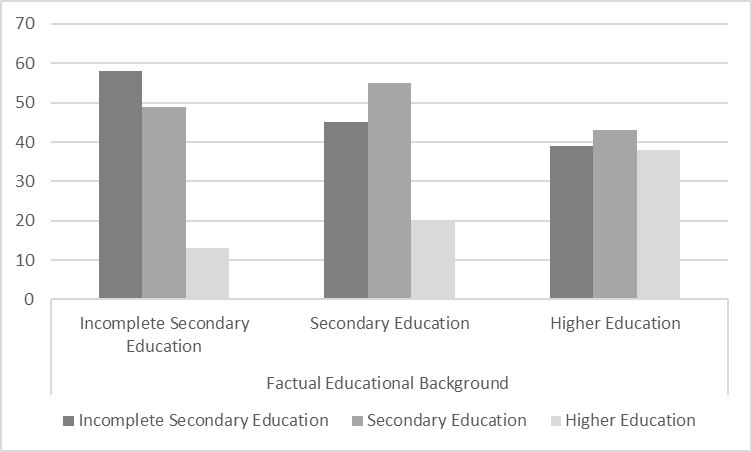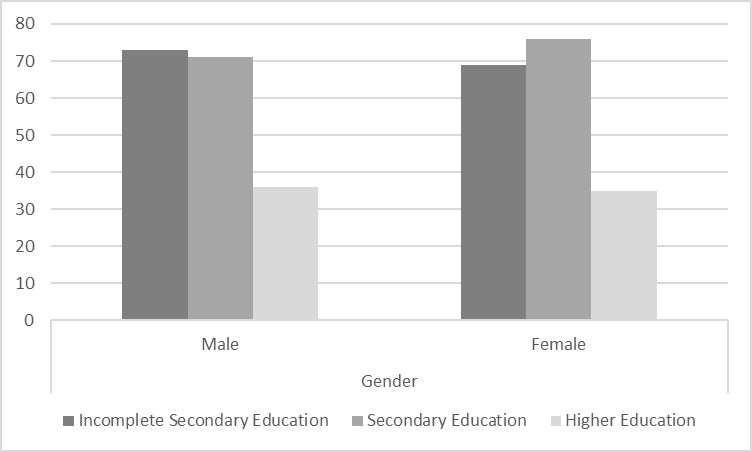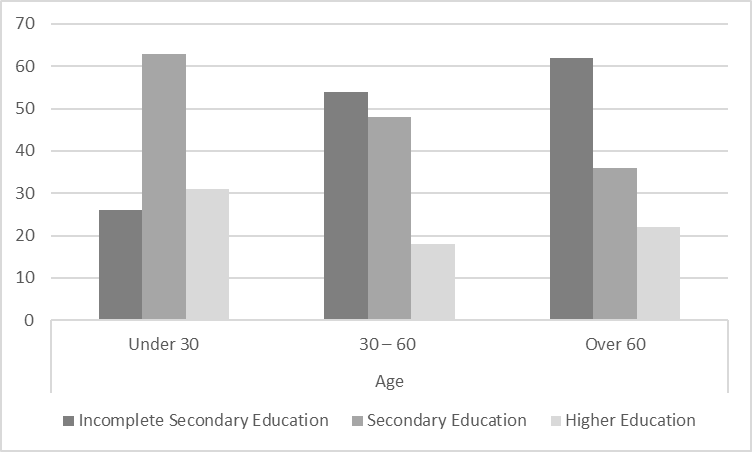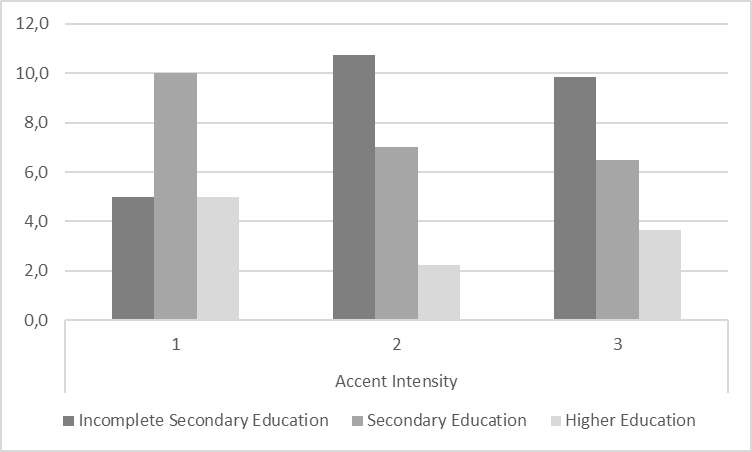Abstract
The question of how an accent influences a person’s image is a specific issue within a more general topic of the language attitude and the image reconstruction by one’s speech/voice. A number of linguistic studies demonstrate that estimating a person by speech is influenced by social stereotypes about the ethnic or social group a certain accent is associated with. Further studies need to be carried out to consider different social groups, particularly national minorities living on the territories surrounded by majority population – native speakers of the national language. The paper presents a linguistic experiment aimed at revealing how the accent in Russian speech of Tartar bilinguals influences the identification of their education level by native Russian speakers. The experimental material included speech audio scripts received from 18 Tartar bilinguals speaking Russian as their second language (the sample of informants was balanced according to their gender, age and education); 20 native Russian speakers participated as listeners. The data analysis demonstrates that while identifying the education level of informants speaking with an accent, native Russian listeners underestimate their factual education level: the higher the intensity of the accent is, the lower estimations of the speakers’ education level are given. The estimation results are also influenced by social factors, age in particular: older speakers get lower estimations of their educational level. These consistent patterns need to be studied further for other ethnic groups residing in Russia.
Keywords: Tartar bilinguals, Russian speech, intensity of accent, education level, estimation
Introduction
A language attitude is one of the most important features of a multilingual situation (Ferguson, 1989). A language attitude includes the estimation of one’s language and other languages it comes into contact with in a certain linguistic situation. In such a situation, languages are estimated according to different parameters: communicative aptitude, prestige, aesthetic value, etc. Apparently, estimations of one’s own language and neighboring languages differ, while estimations of an alien language together with estimations of the ethnic group speaking this language form ethnic stereotypes (Minyar-Belorucheva & Pokrovskaya, 2012). The significance of studying a language attitude in the context of ethnic stereotypes formation is obvious, as long as it can reveal the mechanisms of the language and ethnic conflicts and, consequently, help to plan the language policy accordingly.
In a multinational society multilingual speech represents a continuum of speech acts of monolinguals, each using their own language, and bilinguals/polylinguals, speaking several languages of those present on the given territory. Moreover, the second/third languages are quite frequently spoken with an accent. This accent is also included into the ethnic stereotype (Sharapov, 2009).
Such situation is observed on the territory of the Perm Krai (Russia) with the population of over 2.5 million people of 125 different nationalities (GosKomStat, 2010). The overwhelming majority of the population (87,1 %) is Russian, about 6 % are Tartars (and Bashkirs who speak close dialects of the Tartar language). The Russian population is mostly monolingual (not taking into account foreign language learning), the Tartars are bilinguals. As a rule, among the Perm Tartars the Tartar language is acquired first as the language of intra-familial communication. The Russian language is acquired at the age of 3–7 years old (in a kindergarten or at school) against the background of the Tartar one. The Russian language proficiency of Tartar bilinguals varies from fluent speech without an accent (which is quite seldom) to marked distortions at different linguistic levels.
Taking into account the fact that the Perm Krai population (as well as the population of the Urals in general) is mixed from the point of view of genetics and ethnicity, it can sometimes be difficult to define a person’s ethnic group judging by his/her appearance. However, the accent in Russian speech instantly prompts native Russian speakers that they deal with a representative of an “alien” ethnic group and, as a result, certain stereotypes influence estimating the person in question. Therefore, it is important to understand how speech accent can influence the estimation of bilingual speakers.
Problem Statement
The problem of the accent influence on the formation of a person’s image is a specific issue within a more general topic of the language attitude and image reconstruction by one’s speech/voice (Andrews 1995; Garret, 2010; Krause, 2013; Kristiansen & Grondelaers, 2013; Kuznetsov, 2020; Manerov, 1993). Various studies demonstrate that, judging by one’s voice, the listeners correctly identify the speaker’s gender, age, height and weight because these factors influence the voice pitch directly; these data are already used for automatic identification (Kuznetsov, 2020; Sinsha 2019). However, when speech in a foreign language is estimated, the correctness of the discussed parameters diminishes significantly (Potapova, 2005), as these speech characteristics are socially determined.
Research carried out on the material of the Russian language shows that social parameters of the speakers are not reliably defined by the voice and the manner of speech. For example, the study of Manerov (1993) proves that Russian speaking listeners identify the speaker’s profession correctly in 5–60 % of cases (with the exception of some professional groups that either require a high level of speech culture or call for preserving local speech peculiarities). However, listeners turn out to be more successful in defining the education level of the speakers.
Consequently, speech serves as a basis for reconstructing a speaker’s image. Speech accent influences its perception and, thus, the reconstructed image; this issue will be discussed in the paper.
Research Questions
The influence of accent on speech estimation was described by Trudgill (1975), who studied how speech with and without an accent is perceived and came to the conclusion that arguments made by speakers with standard pronunciation are perceived by the listeners as more convincing than those made by speakers with an accent. Moreover, speakers who follow the orthoepic norm are estimated as being clever, cultured and influential.
Other studies confirmed these results (Ball, 1983; Brennan & Brennan, 1981); however, they proved that various foreign accents and accents of local dialects differ in the way they are interpreted by the listeners. Thus, in Australia speakers of territorial dialects are estimated as unqualified, though well-intentioned Italian immigrants – as unqualified and lacking self-confidence; German immigrants, by contrast – as qualified and authoritative (Ball, 1983). Cross-cultural studies of how the Spanish, Arabic and Korean accents in English speech are interpreted by native speakers and bilinguals (the Spanish, Arabs, Koreans) demonstrated that non-native English listeners have a more negative attitude to accents of foreign language learners than native English ones do. Besides, the tree accents in question received different estimations: the Arabian accent was estimated significantly lower that the Korean and Spanish accents (Barona, 2008).
The Russian language was used for studying the perception of dialect speech of different regions (Andrews, 1995; Krause, 2013; Krause & Podrushnyak, 2010). The studies using various methods showed that standard Russian pronunciation is estimated as more prestigious than dialect pronunciation, and that social and cognitive characteristics of standard speakers are estimated higher than those of dialect speakers. In particular, dialect speakers receive lower estimations of their education level (Krause & Podrushnyak, 2010).
Taken together, these studies demonstrate that estimating a person by his/her speech is influenced by social stereotypes about the ethnic or social group a certain accent is associated with. Consequently, it is important to reveal this consistent pattern for various social groups, particularly, for national minorities who live on the territories surrounded by majority population – native speakers of the national language.
Purpose of the Study
The purpose of the study is to reveal the influence of the Tartar bilinguals’ speech accent on the estimation of their social parameters, namely their education level, by native Russian speakers. Besides, the influence of social parameters, such as gender and age of the speakers, is considered.
Research Methods
The method of a linguistic experiment was applied in the study: the participants were asked to listen to 18 fragments of bilingual speech and to estimate the education level of the speakers. The choice of three variants was given for estimation: incomplete secondary education, secondary education, higher education.
The audio scripts used in the experiment were taken from the sounding chrestomathy “Spontaneous Russian speech of Tartar bilinguals of the Perm Krai” (2010, 2012). While selecting the audio scripts, social parameters of the speakers (Tartar bilinguals) were taken into account. The sample of the speakers was balanced in relation to the following factors: gender (male and female), age (3 age groups were included: the speakers aged under 30, the speakers of the 30–60 age group and the speakers over 60), education (incomplete secondary – I, secondary – S, higher – H). As far as the Chrestomathy did not contain enough speech fragments received from the speakers with the chosen parameters, three audio scripts were added.
The length of the audio scripts varied from 10 to 20 seconds. While choosing the scripts the authors were guided by the following principles: 1) the speech fragment was not supposed to include any lexemes whose semantics could denote the social status of the speaker; 2) the speech fragment was not supposed to include any grammatical or lexical errors. However, the second principle was only partly observed: speech fragments without lexical errors were chosen, while grammatical errors are steadily present in the majority of the scripts, which is determined by a strong influence of the Tartar grammar and a specific form of the Russian language (emerging as a result of interference with the native language) that the speakers acquire since childhood.
Table 01 presents the results of the expert analysis of audio scripts. The speech of each informant was estimated by an expert-phonetician according to the accent intensity: from “1” (low accent intensity) to “3” (high accent intensity). Besides, the analysis of the speech fragments in relation to the presence of intonation, vocal and consonant peculiarities was carried out. As far as complete elimination of grammar errors turned to be impossible, their influence was also taken into account (in the table the presence of grammatical errors in the speech of certain informants is marked). These data are necessary for objective description of the experimental results.
As is shown in Table 01, the sample included 8 bilingual speakers with low accent intensity, 4 speakers with medium accent intensity, and 6 speakers with high accent intensity. Social parameters and accent intensity could not be balanced because they are interconnected: the presence of the accent depends, among other factors, on social parameters. However, each social group includes the speakers with all the three degrees of accent intensity.
10 men and 10 women with a different social status aged from 18 to 55 took part in the experiment; all of them are monolingual native Russian speakers. The participants were asked to listen to audio scripts of spontaneous speech by Tartar bilinguals and, after listening, to estimate the speakers’ education level. The total of 20 answers for each audio script was received.
Findings
The received results are presented in Table 02. As we can see, among the speakers with incomplete secondary education (“I”), the highest estimations were received by МI1 and FI1 (the youngest speakers): their prevailing estimation was “S”, while individual “H” estimations were also given. These speakers have the lowest degree of accent intensity, though one of them has grammatical errors in speech. The speakers were on average estimated accordingly to their factual education level.
Among the speakers with secondary education the lowest estimations were received by MS3 and FS3 (the oldest speakers): their prevailing estimation was “incomplete secondary education”. For these bilinguals the degree of accent intensity was estimated by the expert as 3 and 2, the speech of both contains grammatical errors. The other speakers with secondary education were on average estimated accordingly to their factual education level.
The biggest number of mismatches between the listeners’ estimations and the speakers’ factual education level is observed for bilinguals having higher education. Only one speaker (MH1) has average estimations according to his factual education level; the accent intensity in his speech is 1; grammar mistakes occur. Three speakers received the “incomplete secondary education” estimation (MH2, FH2, FH3 – the intensity of their speech accent is 2, 2 and 1 correspondingly; grammar mistakes are present in the speech of the two latter bilinguals). The education level of the speaker FH1 was on average estimated as secondary (the accent intensity is 1). The estimations of the educational level of the MH3 speaker were distributed almost equally between all the possible answers (his speech accent intensity is 3, while no grammar mistakes are present).
Overall, the average estimation of the education level of 9 amongst 18 speakers (50 %) coincides with their factual education level. The education level of other 50 % of the speakers was underestimated. In this case, the lower the education level of the speaker is, the more it coincides with the estimations of the listeners; the most incorrect estimations of the listeners refer to higher education of the speakers (see Fig. 01).
Such estimations can be connected both with the gender and age of the speakers, as well as with some linguistic characteristics of their speech, accent in particular. Let us consider first the dependence of the education level estimations on the gender and age of the speakers (see Fig. 02 and 03).
Figure 03 demonstrates that estimations of the education level of men and women are approximately similar, being a little higher for women. However, the speakers’ age (estimated by the voice pitch) influences estimations of the education level: the older the speaker is, the more often the answer “incomplete secondary education” is given, while for younger speakers the answer “higher education” is more common. Thus, generally we observe the absence of gender stereotypes concerning the education level, but there is the stereotype that younger people are more educated than older ones (at least, while estimating accent speech).



Figure 04 shows the relation between the accent intensity and estimations of the education level. It can obviously be seen that accent intensity influences education level estimations: lower accent intensity implies a bigger number of “higher education” or “secondary education” estimations and a smaller number of “incomplete secondary education” estimations. The second and third degrees of accent intensity differ only slightly: the second degree is related to a bigger number of the “incomplete secondary education” and “secondary education” estimations, while the third one is related to the “higher education” estimation.

Conclusion
The study of accents of the Russian speech of Tartar bilinguals living in the Perm Krai demonstrated that while identifying the education level of a bilingual speaking with an accent, native Russian speakers underestimate their factual education level. Overall, the following tendency is observed: the higher the intensity of accent in speech is, the lower estimations of the education level a person receives. However, though the expert defined 3 degrees of the accent intensity (weak, medium and high), only two degrees (weak and high) are significant (medium accent degree is most commonly combined with the high one). The estimation result is also influenced by social factors, age in particular: the older the speaker is, the lower estimations of the education level he/she receives (which is confirmed by other case studies of Russian and other European languages).
Consequently, estimations of the education level (being one of the components of reconstructing a person’s image by speech) by native Russian speakers are influenced by a variety of factors, among which the accent and age are the most significant. These consistent patterns need to be studied for other ethnic groups living in Russia, which will enable to reveal general and specific principles of image reconstruction while perceiving accent speech by native Russian speakers.
Acknowledgments
The authors thank all the participants of the experiment, as well as RFBR for the support of the research (projects No. 19-412-590001 and 17-29-09074).
References
Andrews, D. R. (1995). Subjective Reactions to Two Regional Pronunciation of Great Russian: A Matched-Guise Study. Canad. Slavonic Papers, 37, 89–106.
Ball, P. (1983). Stereotypes of Anglo-Saxon and Non-Anglo-Saxon Accents: Some Exploratory Australian Studies with the Matched Guise Technique. Lang. Sci., 5(2), 163–183.
Barona, D. V. (2008). Native and non-native speakers’ perceptions of non-native accents. LL J., 3(2), 103–111.
Brennan, E., & Brennan, S. (1981). Accent scaling: language attitudes and reactions toward Mexican-American English speech. Lang. and Speech, 24(3), 207–221.
Ferguson, C. A. (1989). The issues of the influence of linguistic situation on second language teaching. The new in foreign linguist., 25, 122–127.
Garret, P. (2010). Attitude for Language. Cambridge University Press.
GosKomStat (2010). All-Russian Population Census 2010. https://www.gks.ru/free_doc/new_site/perepis2010/croc/perepis_itogi1612.htm
Krause, M. (2013). Das Image regionaler Varietäten als Indikator sozioling. Kompetenz u. metaling. Bewusstheit: HerkunftssprecherInnen u. monoling. MuttersprachlerInnen im Vergl. In Dt. Beiträge 15. Int. Slav. kongress (pp. 175–185). Verlag Otto Sagner.
Krause, M., & Podrushnyak, V. (2010). The image of language varieties of modern Russia: the significance of linguistic and extralinguistic factors. In Language and Society in Present-Day Russian Federation and other Countries (pp. 353–356). Akademiya nauk.
Kristiansen, T., & Grondelaers, S. (2013). Language (De)standardization in Late Modern Europe: Experimental Studies. Novus Press.
Kuznetsov, A. (2020). How voice robots identify speech and what they cope with better than human operators. https://rb.ru/opinion/luchshe-zhivyh-operatorov.
Manerov, V. K. (1993). Experimental and theoretical basis for social identification and interpretation of the speaker [Doctoral dissertation]. St. Petersburg.
Minyar-Belorucheva, A. P., & Pokrovskaya, M. E. (2012). Ethnic stereotypes in modern linguistic world. National Psycholog. J., 2(8), 90–94.
Potapova, R. K. (2005). Subjective-oriented perception of foreign speech. Topics in the Study of Language, 2, 46–64.
Sharapov, V. V. (2009). Actual issues of studying positive ethnic identity, intercultural and interethnic interaction of the population in Povolzhye. Topics in the Study of Pedag. and Psychol., 3, 196–201.
Sinsha, G. R. (2019). Advances in Biometrics: Modern Methods and Implementation Strategies. Springer Nature.
Trudgill, P. (1975). Accent, dialect and school. Edward Arnold.
Copyright information

This work is licensed under a Creative Commons Attribution-NonCommercial-NoDerivatives 4.0 International License.
About this article
Publication Date
17 May 2021
Article Doi
eBook ISBN
978-1-80296-106-5
Publisher
European Publisher
Volume
107
Print ISBN (optional)
-
Edition Number
1st Edition
Pages
1-2896
Subjects
Science, philosophy, academic community, scientific progress, education, methodology of science, academic communication
Cite this article as:
Erofeeva, E. V., Leshchenko, Y. E., & Likhanova, U. L. (2021). Accent In Speech Of Bilinguals And Identification Of Their Education Level. In D. K. Bataev, S. A. Gapurov, A. D. Osmaev, V. K. Akaev, L. M. Idigova, M. R. Ovhadov, A. R. Salgiriev, & M. M. Betilmerzaeva (Eds.), Knowledge, Man and Civilization - ISCKMC 2020, vol 107. European Proceedings of Social and Behavioural Sciences (pp. 472-480). European Publisher. https://doi.org/10.15405/epsbs.2021.05.64

